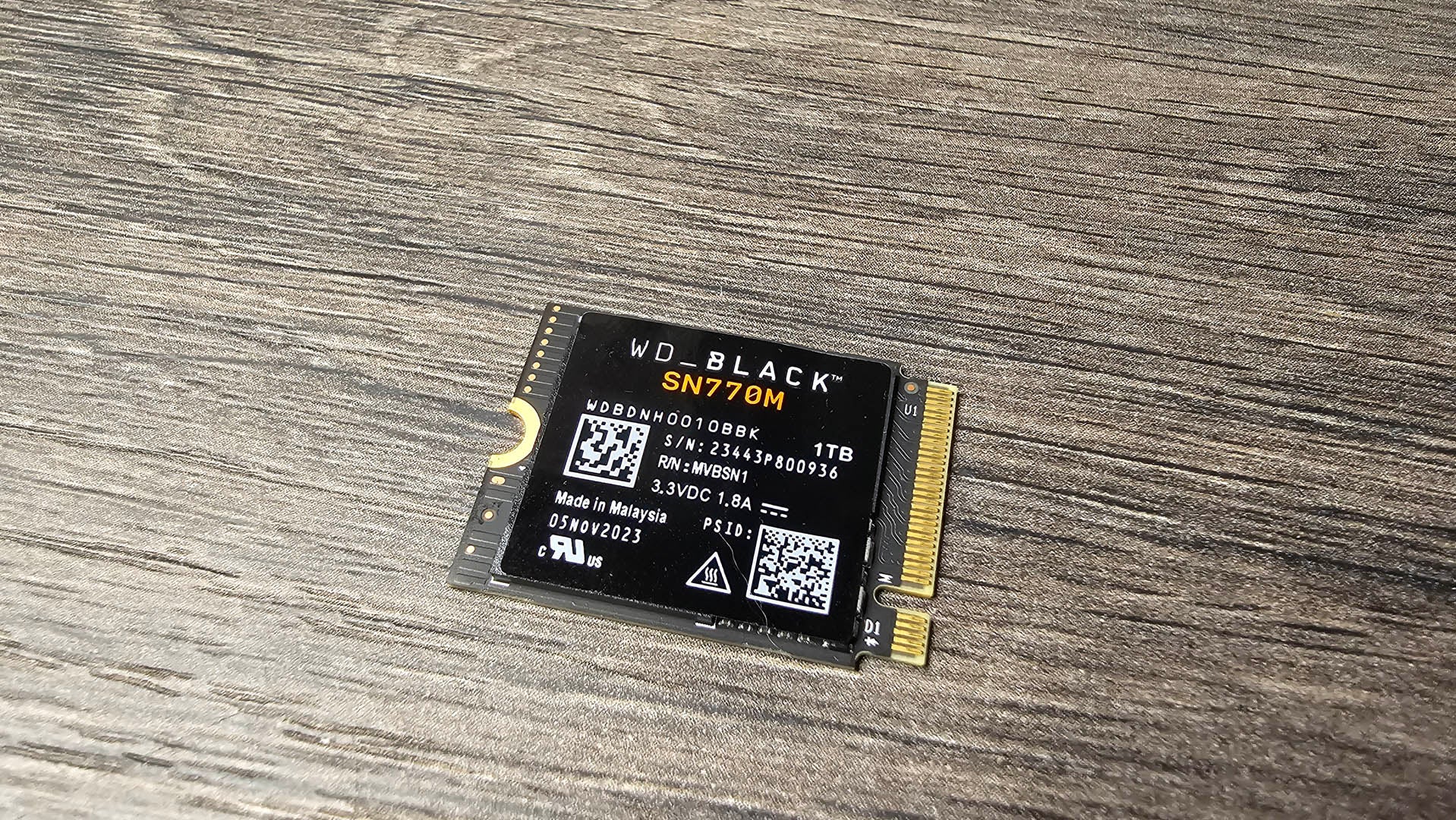Keychron M6 Review
A no-frills productivity mouse with a gaming-grade sensor.
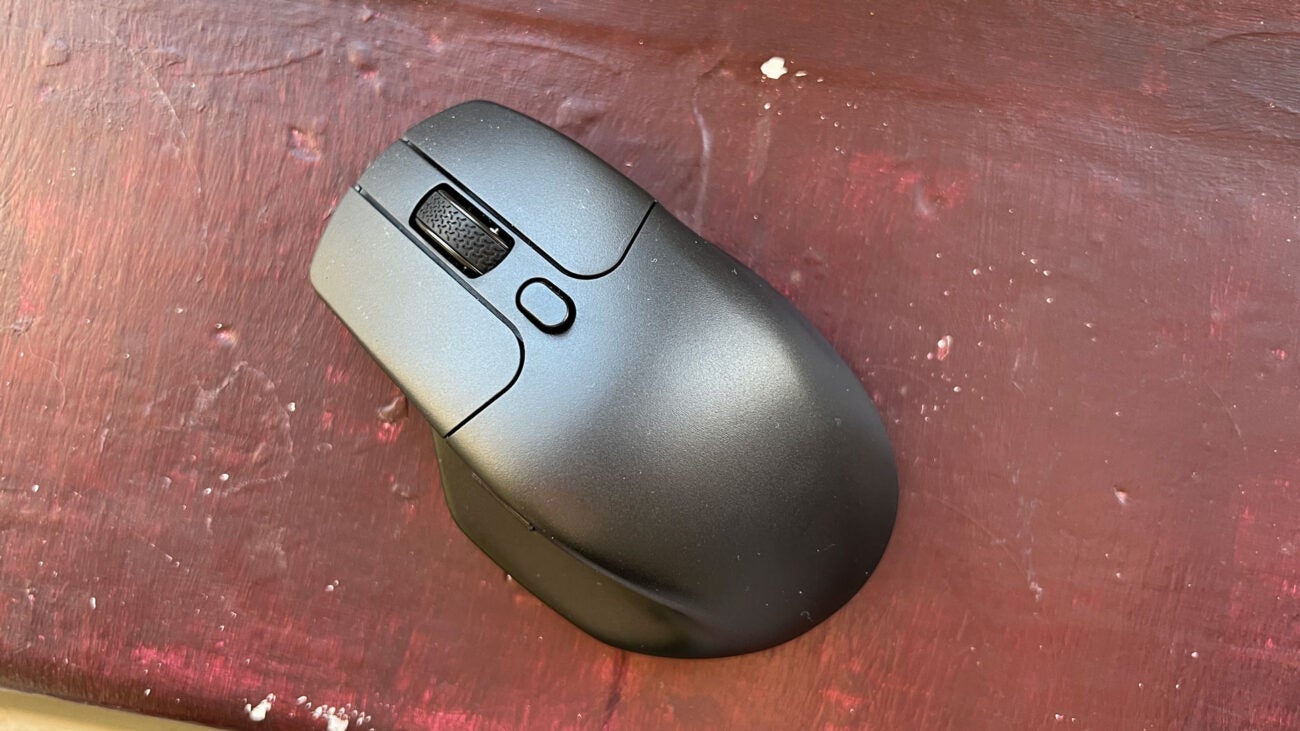






Verdict
The Keychron M6 is a no-frills productivity mouse with a gaming-grade sensor. No matter the task, it’s up for giving it a proper shake. At just £49, it’s an absolute bargain compared to the classics it so clearly references. For right-handed users of any discipline, it’s practically perfect.
Pros
- Excellent battery life
- Gaming-grade sensor in a productivity-focused mouse
- Very cheap
Cons
- Unexciting design
Key Features
- Powerful sensorEquipped with a PixArt 3395 sensor – a very competitive, fast, and accurate optical sensor.
- Excellent battery lifeCan last weeks at a time on a single charge.
- Infinite scrollA free-spinning scroll wheel can be enabled at the touch of a button.
Introduction
Ready and raring to take on productivity mainstays like the Logitech MX Master series, the Keychron M6 Wireless mouse gets a lot right and few things wrong. Any issues are relatively minor in the grand scheme of things, but there’s certainly room for improvement.
In the face of more expensive mice designed to solve the same problems, this is Keychron’s latest attempt. It’s cheap compared to key rivals, which is always a welcome move in a hyper-competitive space and features just enough bells and whistles to appeal to two distinct audiences at once.
The omission of RGB may put some people off, but there are positive trade offs. Here’s my full Keychron M6 wireless mouse review.
Design
- Tall and curvy shape
- Side scroll wheel and Infinite Scroll main wheel
- Dedicated DPI toggle isn’t easy to reach
The Keychron M6 makes immediate references to the long-standing Logitech MX Master series productivity-focused mouse shoppers will quickly notice. The tall body, curved thumb rest, and side-mounted additional scroll wheel are mainstays of the popular clicker, and they’re here on the Keychron M6 as well.
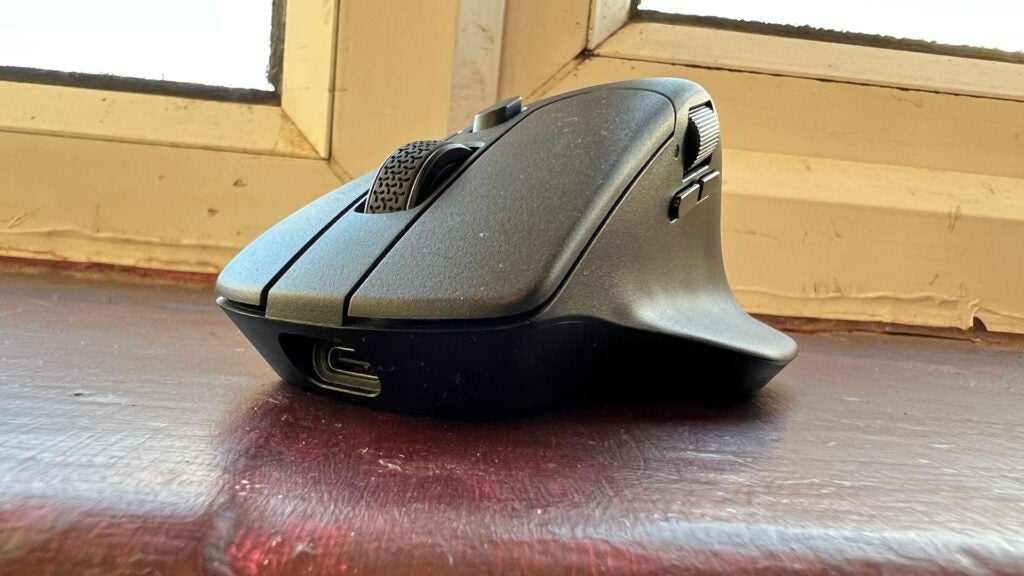
Available only in simple black or white affairs, it’s unlikely to scratch the design itch if you fell in love with the abstract patterns and coloured trim of Logitech’s offering way back when. There’s no detail here to latch onto. It’s as simple as they come, with a lightly textured, uniform plastic look across the whole thing.
There’s no pinky rest – just a slight protrusion on the rear to aid in grip. It’s also quite tall and slopes as aggressively as the aforementioned Logitech, lending itself to the idea of all-day use with a proper palm grip. That being said, it lends itself to just about any grip type so long as you’re not looking for a left-handed fit.
In the box isn’t just a tiny USB-A 2.4Ghz receiver, but a USB-C one as well. The USB-C version will jut out in a way that’ll warrant removing it before sliding your portable office solution into your backpack. Just be aware that there’s nowhere to store either receiver on the device. The inclusion of Bluetooth 5.1 means you won’t even really need a receiver when getting work done at the cafe, though. You’ll also see a decent battery life uplift that way as well.
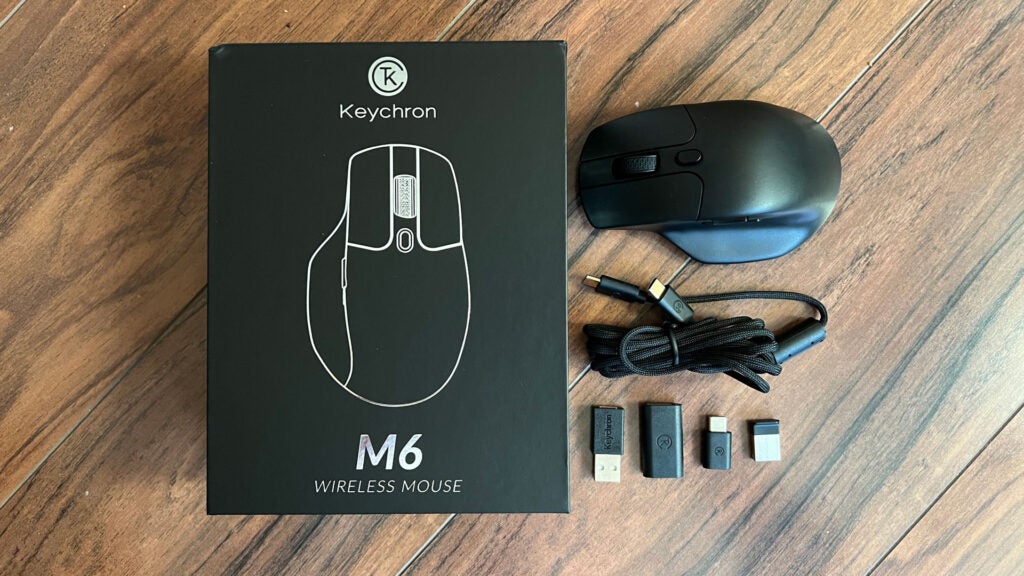
On the top of the mouse, you’ll notice a button perched just behind the mouse wheel. This isn’t for quick DPI switching like most gaming mice out there, but a chunky toggle switch for enabling the Keychron M6’s Infinite Scroll – another feature you’ll likely know all about if you’ve driven one of Logitech’s many clickers in the past.
It doesn’t extend to the side wheel, which protrudes noticeably less than the main wheel and can’t be used as a button. The very front of the Keychron K6 is where you’ll find the USB-C port for charging. This will also cause it to kick into wired mode when hooked up to an active machine. It’s recessed quite far back, which will make using after-market cables a little tricky. It’s an unfortunate design decision you’ll want to keep in mind when traveling to the office with too little juice left in the tank.
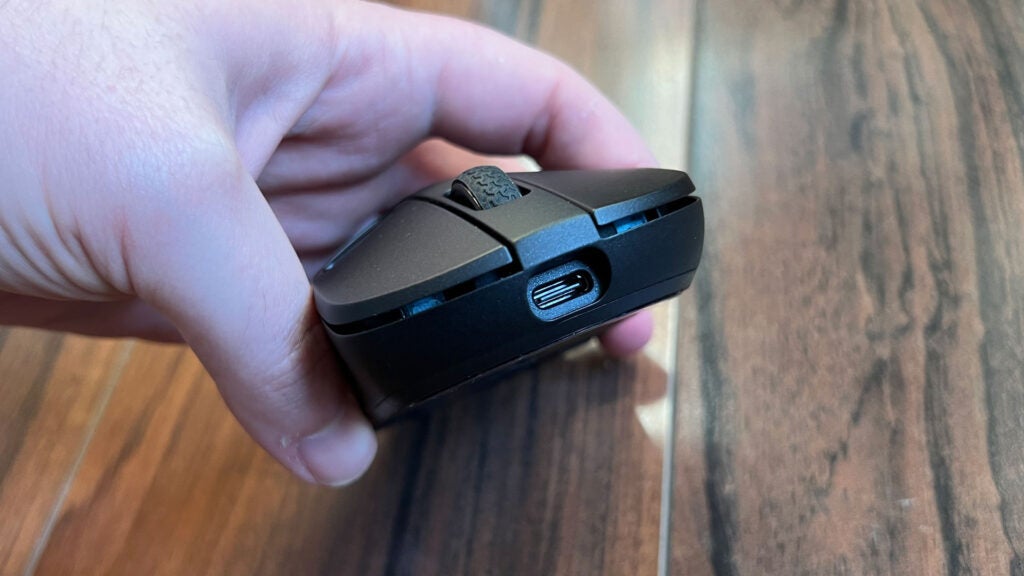
On the bottom is where you’ll find most of the other toggles, with buttons for not only flicking between wired, 2.4Ghz, and Bluetooth, but changing the DPI and Polling Rate, and toggling between three different Bluetooth devices as well. If remember to make proper use of these when changing devices, you’ll likely see some serious battery life perks in the process.
Performance
- Practically perfect PixArt 3395 sensor
- Great battery life
- Good fit for most hands
At around 78 grams, the Keychron M6 isn’t the most lightweight gaming mouse out there. Actually, it’s technically not a gaming mouse at all. But there’s no reason why it can’t be. Featuring a fan-favourite PixArt 3395 optical sensor that Keychron even dubs the “most competitive grade mouse sensor chip”, it’s clear the company had work and play in mind when designing it.
That same sensor enables 1000Hz polling – an omission that made me bin my original MX Master many moons ago – a high 26k DPI ceiling, and 650 IPS. It’s not quite ready to hit the lofty heights of the 2000Hz-equipped Logitech G Pro X Superlight 2 or the ludicrous 8k offering of a Razer Hyperspeed-boosted Viper V3 Pro, but those perks are also largely unnecessary and imperceivable on the setups of the average player.
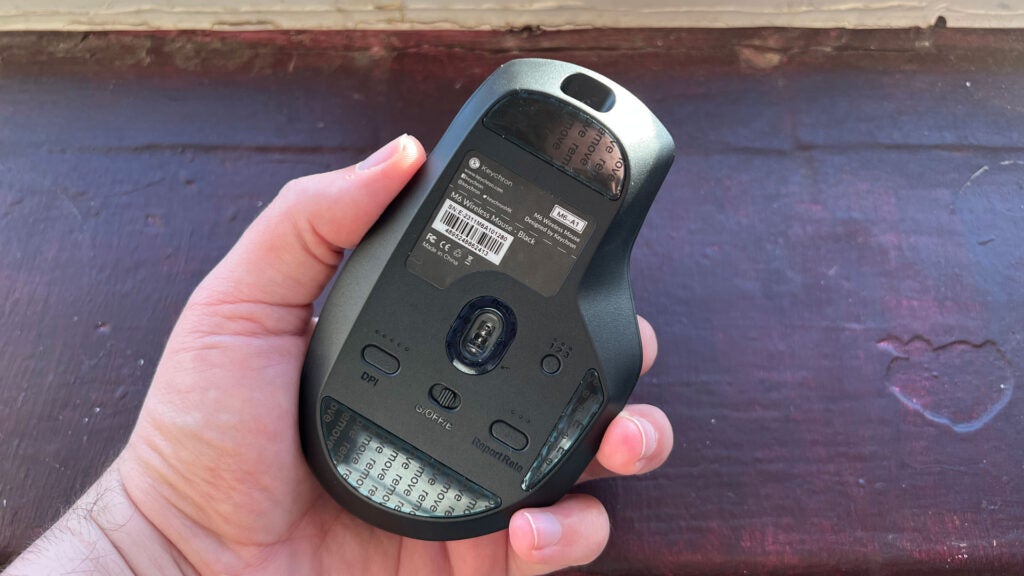
With refresh rates above 60Hz becoming commonplace on even productivity-focused laptops these days, Keychron’s offering nails the sweet spot while keeping its price competitively low.
Used for both work and play over the holiday break, I’m pleased to say I see little reason to swap back to the aforementioned Razer mouse I was running prior to it arriving in my mailbox. Unless you’re playing a tactical FPS title at a professional level, the sensor in this one will serve you just fine.
Getting a little too stuck into Crab Champions than I’d have expected, perfect rounds were just as likely as when I rocked a more gaming-branded clicker. I didn’t notice a single hitch, misstep, or friction-based misclick in the weeks that I put it through its paces. Clicks are sharp and responsive, the side buttons being so close to the wheel somehow doesn’t cause a problem (but could with bigger digits), and the wheel itself has its uses if you’re willing to get creative.
Sure, it doesn’t have the glowing good looks of the SteelSeries Aerox 9 Wireless I pushed hard prior to the Razer Viper, or the mass array of programmable buttons I rely on with my Corsair Scimitar Elite Wireless for Final Fantasy XIV and World of Warcraft, but for the average casual gamer and part-time Reddit lurker, it’s truly everything you could ever need.
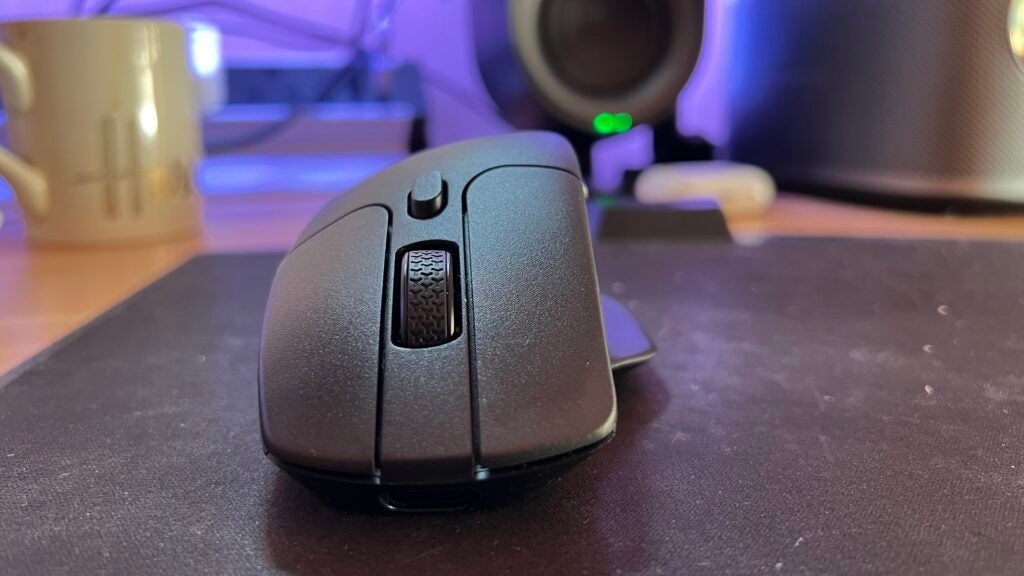
One area where I can see there being a bit of game-centric groaning is with the scroll wheel. When locked into standard scrolling, there’s a noticeable “thunk” with each movement as it resists the next notch.
It’s great for ensuring you don’t cycle back to the weapon you tried to switch out, for example, but the slight rattle the mechanism invites if you flick it quickly is apparent. There’s also some flex to the right side of the device. You won’t really notice it in general use, but pull out that titan’s grip in a tense moment and you’ll feel it. It’s not something I’d consider to be a structural concern: it’s just not quite as solidly built as it looks.
Software and Lighting
- Modest software support
- No RGB lighting
- Essential tweaks like DPI, polling rate, and lift distance
Up until a little while after launch, customizing the Keychron M6 wasn’t an option. Unlike the dedicated gaming peripheral brands out there, tweaking things with software hasn’t been a focus for the company at all.
Right now, however, it is possible to change how the Keychron M6 performs. Rather than rely on coding your own version of your Keychron device’s firmware, you can use the Keychron Engine software suite to change the core features of your clicker. Your anti-virus software won’t like the download, but you can trust it.
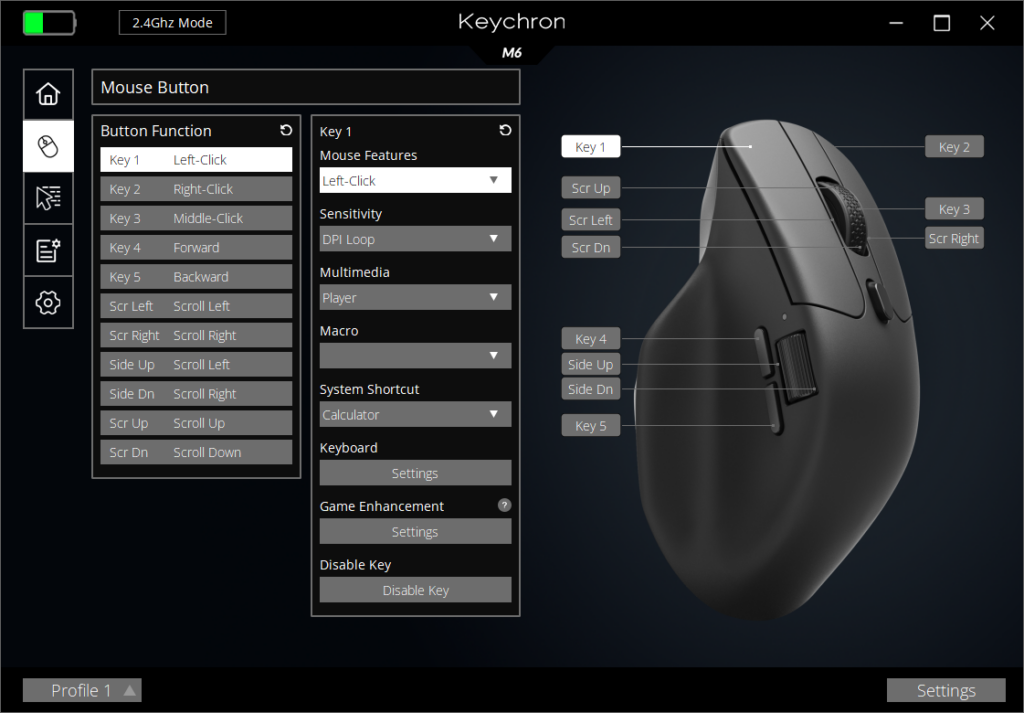
It works just as you’d expect from any other major mouse maker. With the Keychron M6 connected via 2.4Ghz or USB, you can reassign what each button does, tweak things like DPI and Polling Rate to suit your setup and preferred battery life, and even record and assign macros. It’s a nice touch, and one that appears to be rolling out to work with more Keychron peripherals over time.
The software certainly looks like a relic of the past. That doesn’t mean it’s light on features, though. It gets the job done. Advanced tweaks like lift distance, angle snapping, and myriad other movement correction features are there. You can tweak Windows-controlled settings like cursor, scroll, and double click speed while you’re at it, and even add a delay if you deem that necessary.
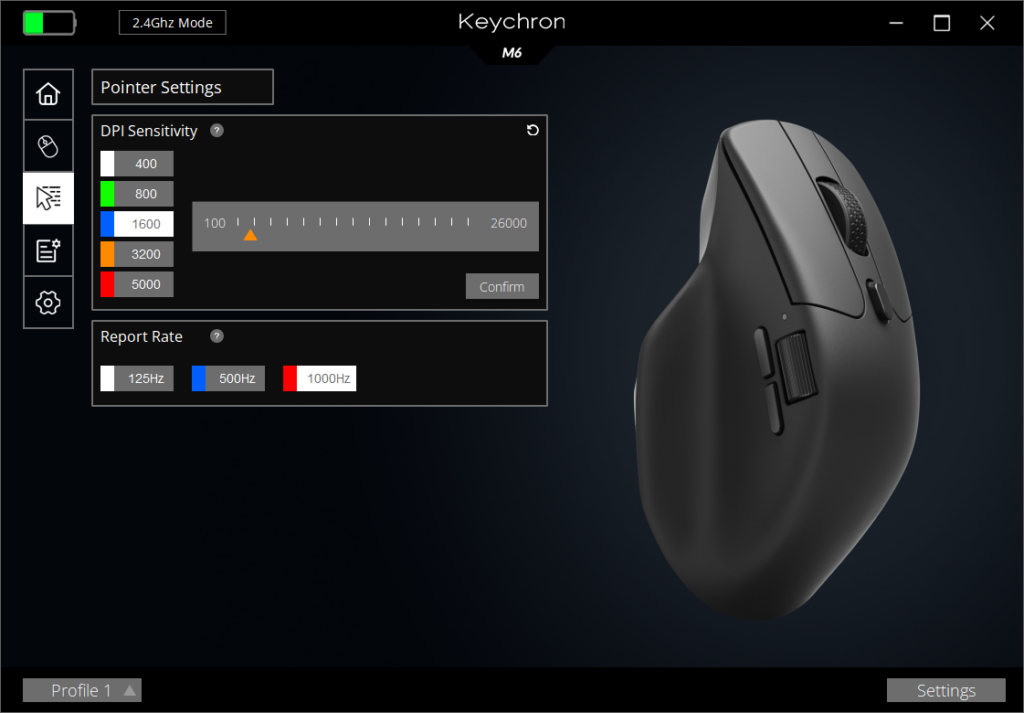
In the case of the Keychron M6, RGB tweaking is out of the question with or without the software. Though there’s a small indicator light on the base for profile reference purposes, it’s the only hint of lighting on the whole body. Again, it’s largely a productivity-focused mouse with the means to game – not that lavish RGB does anything for performance besides hurt battery life: the modern equivalent of speed lines or fire on a Hot Rod.
Battery Life
So lets talk about that all-important battery life. Keychron states an 80-hour runtime here. Curiously, it doesn’t specify whether that’s through a 2.4Ghz connection or Bluetooth, which tends to provide better results. It’s presumably with its default 1000Hz polling enabled, which could see generous energy-savings can if you turn it down to 500Hz, or even 125Hz if you don’t mind the floaty feeling.
Either way, I’m happy to report that the battery life of the Keychron M6 is phenomenal. In weeks of light use, I haven’t had to charge it once. I haven’t used it heavily over the holiday period, but with around 40% left after all this time, it’s clear there’s some very generous standby efforts keeping it going while I’m typing away for work.
I can also report that it wakes up instantly. There’s absolutely no discernable delay in it kicking back in as soon as I reach for it. The same can’t be said for a bunch of dedicated wireless gaming mice I’ve had on my desk in recent months.
Latest deals
Should you buy it?
You want a no-frills mouse that’s great for work and play.
With all the hallmarks of a productivity-focused clicker and the sensor of a gaming goliath, the Keychron M6 is what the Logitech MX Master series should have been a decade ago.
You crave a more personalised peripheral or prefer a slimmer, more portable clicker.
With zero lighting on offer and a shape that does nothing for the lefties out there, there’s plenty of reason to go with a more gaming-focused mouse over the Keychron M6 if personalization is that important to you.
Final Thoughts
Against its most common competitor, the Keychron M6 mouse is a great consideration when shopping for a new productivity-focused clicker. With a powerful PixArt 3395 optical sensor at its heart, it’s a more than capable gaming mouse as well.
At just £49 for an incredibly versatile mouse with the curves to be comfortable for hours at a time, there’s little reason to doubt the performance of the Keychron M6. Those with larger or smaller than average hands might struggle with its tall arch or lack of pinky support, however.
For some, the look, feel, and extra buttons of the Logitech MX Master 3S might still make it the better choice at twice the price. It’s just unusable for any serious gaming with its 125Hz polling rate. The same can be said for the ultra-ergonomic Logitech Lift Verticle. The Keychron M6 just so happens to be a best of both worlds solution at a price that’s hard not to respect. It’s easily one of the best wireless mice you can buy for your money.
How we test
Used over a few weeks in both casual and professional situations.
Tested alongside other mice with similar features.
Compared to mice across various price ranges.
Used over a few weeks in both casual and professional situations.
Tested alongside other mice with similar features and Compared to mice across various price ranges.
Tested the battery life.
Used both Bluetooth and dongle.
FAQs
No, there’s zero RGB flair to the Keychron M6 other than a small indicator on the base of the device.
The Keychron M6 can go all the way up to 26,000 DPI with five on-board profiles.
You can change the polling rate between 125Hz, 500Hz, and 1000Hz on the base of the device or through the optional Keychron Engine software.


